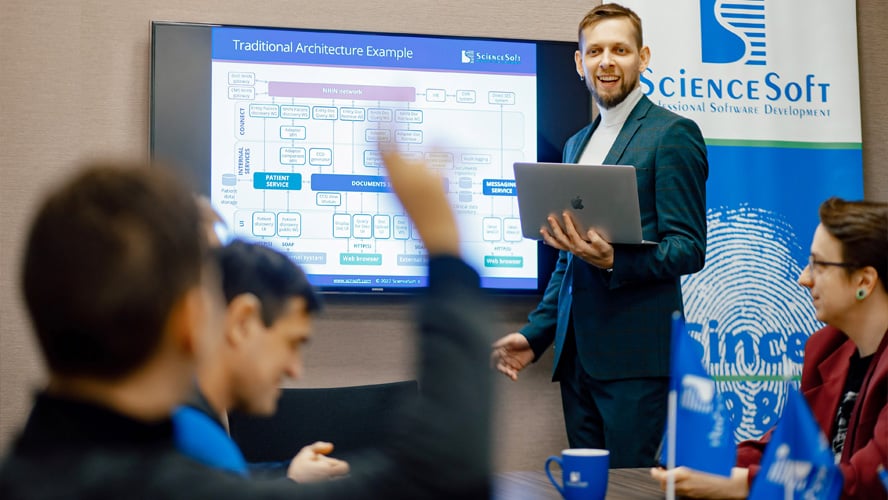Structured company's goals and needs in terms of its governance structure, business processes, and business information. Established metrics to monitor the progress in reaching those goals.
IT Services for Enterprise Architecture
In 36 years, ScienceSoft has never had a project where we just went through the motions. Regardless of our clients’ size, they always find with us responsive and personalized services rather than one-size-fits-all solutions.

Boris Shiklo
Chief Technology Officer, ScienceSoft
IT services for enterprise architecture ensure that the technological backbone of the organization is designed, implemented, and managed in a way that supports existing business processes, evolving goals, and transformational efforts in the most efficient way.
Our awards, certifications, and partnerships
Support Across All Components of Enterprise Architecture
ScienceSoft is ready to assist you in defining and implementing your IT strategy, ensuring effective alignment between your business objectives and IT solutions, enhancing the flexibility and scalability of your IT infrastructure and solutions, and more.
Enterprise architecture
Business architecture
Information architecture
Efficient organization and labeling of data supporting business operations.
Application architecture
Software applications to support business functions and operations and the internal design of these applications (e.g., monolith, microservices, or SOA).
Technology architecture
Components that will run applications: hardware, a tech stack (programming languages, frameworks, libraries, server environments, and tools), software for the deployment, execution, and management of software on a server, cloud services, middleware, databases (relational & NoSQL), network management tools.
Security architecture
Security policies, procedures, and technologies required to protect the organization's information assets.
Integration architecture
The way different IT systems and applications work together to support business functions and operations.
Infrastructure architecture
Physical infrastructures to support business functions and operations, such as data centers, servers, storage, and cloud.
Our assistance with strategic planning is limited. While we can guide your IT leaders and architects by sharing tech insights and best practices, exploring options and comparing alternatives, we believe that strategic planning should primarily stay within your organization. The rationale behind this approach is that an external provider might not understand your business's unique needs as profoundly as your internal team can. An internal team is better positioned to manage stakeholder interests, collaborate across departments, and navigate internal policies to successfully implement the strategy.
ScienceSoft's Scope of IT Services for Enterprise Architecture
FAQ
How do you validate that your IT solutions are cost-effective and beneficial for your clients?
We carefully tailor IT solutions to your business needs, ensuring alignment with your strategic objectives. Before any project starts, we conduct a detailed cost-benefit analysis to guarantee benefits surpass costs. Our agile methodology enables flexible, iterative implementations, enhancing delivery speed and allowing adjustments based on continuous feedback. We set clear performance metrics to gauge the impact of our solutions on your goals, facilitating ongoing improvement. Leveraging cloud technologies, we minimize hardware and maintenance expenses. Additionally, we offer customized training to ensure your staff can effectively utilize the new IT solutions.
What KPIs do you use to measure the success of service delivery?
Success is measured through a set of KPIs tailored to each project, including but not limited to ROI, time-to-market for new products, cost savings achieved, system uptime, user satisfaction, and compliance levels. We establish these KPIs early in the project planning phase and use continuous monitoring and feedback loops to ensure we meet or exceed these metrics.
As we're planning for future growth, it's important for our IT systems to be both scalable and adaptable. Can you explain how you design systems with these considerations in mind?
We use modular design principles, API-first architectures, cloud-native technologies, IT management automation, etc. This allows for components to be easily added, removed, or scaled based on your evolving business needs.
What strategies do you use to ensure full engagement and buy-in during the planning and implementation?
Our approach involves consistent, customized communication, including workshops and presentations, throughout the project. We employ visual aids and prototypes to clearly illustrate impacts and benefits, ensuring stakeholders are well-informed and active in decision-making.
Recognizing that customers often have multiple stakeholders with varied opinions and priorities, we collaborate closely with all parties. We find synergetic solutions and effective compromises together with stakeholders, driving and facilitating the process.
We have some legacy systems that we're not ready to retire yet. What is your approach in such cases?
Our approach to legacy systems is pragmatic, focusing on maximizing value while minimizing disruption. We conduct thorough assessments to decide whether to modernize, integrate, or replace legacy systems.
Should the decision lean toward modification, we comprehensively reengineer the system to understand all dependencies, discuss backward compatibility, and establish robust rollback plans to minimize potential disruptions. Our strategy also includes incremental updates and running old and new systems in parallel when possible, allowing business operations to continue smoothly on the existing infrastructure while parts of the system are modernized.
Can you detail your experience with cloud architectures?
Since 2013, we specialize in building and maintaining high-performance cloud infrastructures, ensuring their security, stability, and cost-effectiveness. Our expertise covers public, private, and hybrid cloud models, and we're proud partners of AWS and Azure. Our approach has led firms to achieve significant benefits: an 80% reduction in cloud costs through strategic service selection and configuration, a 36% decrease in user issues thanks to enhanced cloud app stability and proactive support, 100% software uptime following re-architecting and cloud migration, and seamless 24x scaling of servers due to optimal architectural decisions.
























